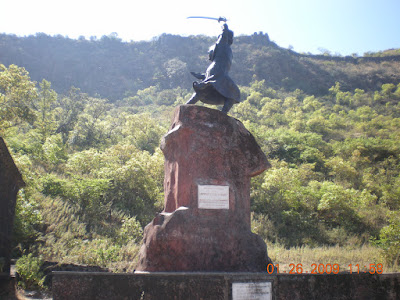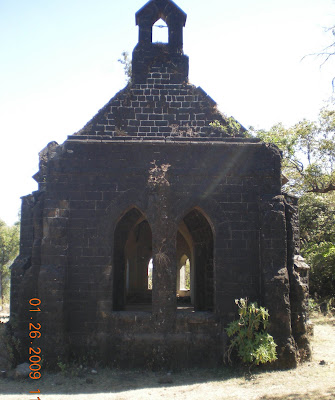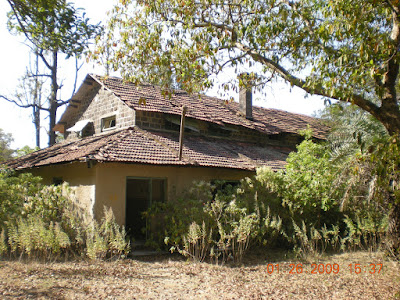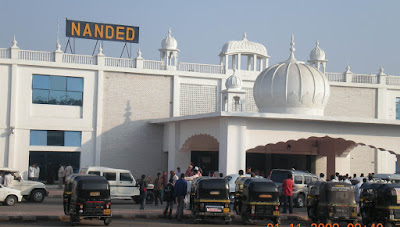The Departure

से My Photographs
Even before the day begun on January 26th, we had decided to go to Purandar fort this time. There was a lot of deliberation over the matter between us friends for over two months. But it would have been foolish to let go this opportunity given by Republic Day to refresh ourselves. Our first choice was Rajgad, but as one by one members of our team walked out, only me and Tanaji found ourselves on the road. It was about eight o’clock in the morning when Tanaji drove away from Swargate, me riding behind him. He took me all the way to the fort and bought back safe and sound. When we were back, I felt each part of my body was rebelling like the people in socialist parties do. I could just wonder what the condition of Tanaji was.
The Road to Hell

से Purandar
While embarking on the trip, we had no fair idea as to what is the condition of the road to this historic fort is. I had read many times kind of travelogues trekkers and tourists have written about the fort. In July last year, I almost made it to the fort but came away midway sincew I thought I would not get enough time. I was correct in that respect as the fort stretches to a bvast land and it has a hright of almost 22,000 ft above sea level.

However, it is the road to the fort that tests one’s patience and endurance. It seems as if the road was made in tar first at the time of Shivaji and since then there has been no repairs. The pebbleshave all beenspread on the road as if one spreads butter on a slice of bread. The vehicle have to be extra conscious for being skid or developing punctures. It also consumes a lot of energy also. If the second most important fort in Shivaji’s kingdom can be neglected like this, how far can one expect about other historical places. The slope leading to Purandar fort is one of the messiest roads in the world, to say the least. If anybody asks me an advice, I would rather say that take your vehicle to the base of the fort and thereon keep climbing by foot. It will consume your time and energy, but it won’t bring you a sense of helplessness, loneliness and frustration which the vehicle road will bring. And if it is dangerous and tiresome while climbing, it is 100 times more dangerous and time consuming while coming down.
The First View

से Purandar
The path to fort might be beset with difficulties, but once you set your foot at the entrance of the fort, it is only history and valor that surrounds you. At the entrance of the fort, a statue of Murar Baji Deshpande has been erected in honour to this great fighter. Murar Baji was the custodian of the fort when Moghul commander Dilerkhan attacked the fort in 1665 Dilerkhan bombarded Purandar with artillery but could not win over the fort. With his handful of men, Murar Baji was fighting the enemy. It is said that Khan had offered him to come to Mughals and be rewarded but he chose otherwise. This brave warrior gave up his life in defending the fort for his beloved king, Chhatrapati Shivaji. The statue sufficiently shows the bravery and valor of the fighter. It also reminds one that Maratha empire was created from the contribution of such selfless people.

The statue is at a relatively flat area and there is a lake nearby. In historic times, this might have been used by the people living on the fort for drinking water but is not used now. As one passes by the statue, the grand remnants of the fort can be seen in the background.
The Grand Neglect
If you think you can skip Purandar for want of excitig attractions, you may be forgiven. It does not have the proximity or ease like Sinhgad and it does not have charm or monuments like Shivneri or Pratapgad. Whatever remnants one sees on Purandar are standing in utter neglect. To make it worse, no information about these mute witnesses to history is available on the fort. There are buildings on the fort suggesting that British officers enjoyed a good stay here prior to 1857 but that is also not explicitly displayed. We can draw only inferences or make guesses based on the structures. There are two identical buildings here which might have been churches as the place for bell can be clearly seen. The walls of these churches have been littered with names of those who unfortunately happened to have visited the sites. Unable to produce such grand examples themselves, they have instead chose to put their names on the existing building.

से Purandar
There are also barracks on the fort supposed to be used by the soldiers of East India Company. All these are abandoned now except for those which are given to National Cadet Corps. NCC controls some part of the fort even now.

After returning to Pune, when we searched the history of the fort, it was found that the German war criminals were placed on the fort after the two world wars. The construction of the buildings and manner in which they are standing reinforces the fact. The authorities, that of Archaeological Survey of India (which controls the fort) and revenue department of Maharashtra (under which the territory comes) either think that every tourist is well informed about this history or they just do not want everybody to know the same. Otherwise they would have placed some boards, guides or something to that effect. The forgotten grandeur of this historic witness is matched with the equally grand neglect by present authorities.
The Vast Expanse

से Purandar
Looked from the Narayanpur, from where only you can go to fort, Purandar seems very small. Its magnificence is not so imposing as the Sinhgad. But once you are at the top, one realizes what an expanse this fort has. Along with its twin fort, Vajragad, the fort has a vast expanse. Though most of the places which might have served for the cause of Shivaji’s Sawrajay have now become extinct. We could not find many places where we could identify the exact places of incidences, except for Sambhaji’s birthplace. Chhatrpati Sambhaji, son of Shivaji was born on this fort on 16 May 1657. After about a two centuries, Sawai Madhavrao Peshwa was born on this fort. After the fall of Maratha empire, the fort came to East India Company.

The Modern History

से Purandar
It is not that Purandar is condemned to perpetually lost in the nostalgia of an empire building at few point of times in history. Until now, it was home to the human footprints and ventures. We could spot two buildings which served as bakery during 18 and 19th century. The building is one of the classic examples of British era buildings and has many features which are hardly seen now.

Take for example this building. It has heaths, fireplaces and exquisite curves in walls. Now no one lives in the building. It seems it has been preserved for a future project of ghost town. And why British, even post-independence era structure are left to live in the company of wild bushes and trees. Just in front of this building, there is stage made from cement concrete. It took us about ten minutes for us to spot the foundation stone of the stage which declares that it was inaugurated in 1970. Within 40 years, it has been transferred in not more than a tomb. It was supposedly named Yashwant Rangmanch.
After wandering for over two hours, we called it a day. There was nothing more to see. But we amused ourselves with a group of fort lovers who were busy reciting powadas, a kind of ballads in honor of historic warrior. When asked for water bottle, the lone vendor at the fort said it would cost us Rs 25. We preferred not to take it and instead drank cold drinks once were in Narayanpur. That did not prevent us from tasting the bhel at fort itself. We would never had relished such a common fare had we been not tired of walking in the sun. All in all, we did nothing great, did see nothing great but for us, it was a great experience.
When we were returning, both of us were dissatisfied that there was no relic here which we would have remembered for life. Still, we promised each other to return in the monsoon season when Sahyadri is adorned with greenery. Hope, better luck then!
Technorati Tags Day,Republic,Trip,Purandar,Pune,Fort
 About three years ago, I spent my Republic Day holiday wandering in Pune with my friends. That was the day when I saw Shaniwar Wada first time. This time around I was at Purandar. Yesterday we went to here with my friend Tanaji. The famous fort in the history of Maratha empire. This was the fort where Chhatrapti Sambhaji born. Many a sites on the fort are in ruins. I am going to write about it later. But what made our trip special was that it was a Republic Day and we were on a fort once owned and occupied by Chhatrapati Shivaji.
About three years ago, I spent my Republic Day holiday wandering in Pune with my friends. That was the day when I saw Shaniwar Wada first time. This time around I was at Purandar. Yesterday we went to here with my friend Tanaji. The famous fort in the history of Maratha empire. This was the fort where Chhatrapti Sambhaji born. Many a sites on the fort are in ruins. I am going to write about it later. But what made our trip special was that it was a Republic Day and we were on a fort once owned and occupied by Chhatrapati Shivaji. Even though the name
Even though the name 













